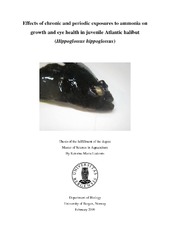| dc.description.abstract | The effect of chronic and periodic peaks of un-ionised ammonia (UIA-N) exposure on growth and eye health in juvenile Atlantic halibut, Hippoglossus hippoglossus, were examined. Fish with mean initial weight 51.7 g (SD, 13.2) were exposed to five treatments consisting of control group, three groups (ChronicLow, ChronicMedium and ChronicHigh,) chronically exposed with UIA-N ranging from 0.06, 0.12 to 0.17 mg l-1 respectivly for 62 days at 11.9ºC, pH 8.0 and salinity 34 and one group (HighPulse) exposed to the same high levels as above for a short daily period. The fish were reared under these treatments for 62 days. Growth was significantly reduced at UIA-N concentrations above 0.12 to 0.17 mg l-1. Mean weights and growth rates were significantly lower in groups exposed to chronically high ambient ammonia concentrations compared to corresponding control group throughout the period with ammonia treatments. Chronically low ammonia concentration did not have significant effect on weight and growth rate (NOEC= no observable effect concentration 0.06 mg l-1 UIA-N). The subsequent period of the experimental study (until day 100) no ammonia was added and water quality was normalized. However, weight differences were still present at day 100, although adaptive growth rates were observed in the previous chronic ammonia groups. The simulated postprandial peak (HighPulse) did not have any significantly effects on either weight or growth rate in the present study, and the threshold limits for these peaks are yet to be determined. Minor differences were found in blood physiology between treatments. No significant cataract formation was observed between the treatments. Previously unreported free amino acid composition in juvenile Atlantic halibut is presented in the study. Significantly difference in the imidiazole anserine was found in the group exposed to high ammonia (ChronicHigh). The eye histidine status differed significantly at day 62, and also osmotic differences (measured as NAH) were found in all group exposed to chronic levels of ammonia. | en_US |
